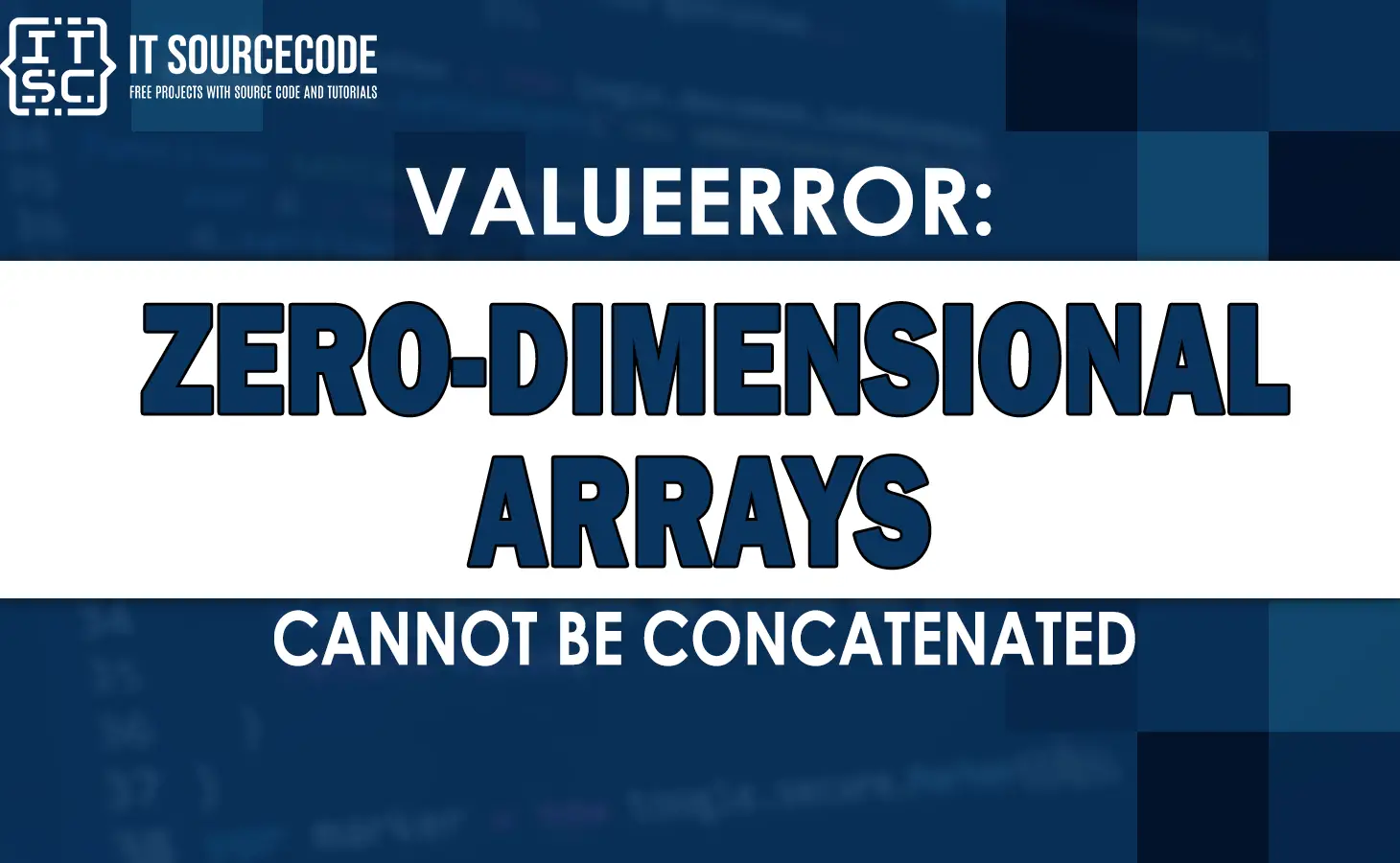One of the common errors that programmers often encounter is the ValueError: Zero-dimensional arrays cannot be concatenated.
This error message typically occurs when you are trying to concatenate arrays that have zero dimensions, resulting in an invalid operation.
What is the ValueError: Zero-dimensional arrays cannot be concatenated error?
The ValueError: Zero-dimensional arrays cannot be concatenated error typically occurs when attempting to concatenate arrays with zero dimensions.
A zero-dimensional array, also known as a scalar or a 0-D array, represents a single value in NumPy.
It doesn’t have any dimensions or shape and it is necessary a single element.
Concatenating a zero-dimensional array with another array is not allowed because the resulting operation is unclear.
To better understand this error, let’s take a look at some examples of how the error occurs.
How the Error zero-dimensional arrays cannot be concatenated Occur?
Here’s an example of how the error zero-dimensional arrays cannot be concatenated occur.
Example 1: Concatenating a zero-dimensional array with a one-dimensional array
import numpy as np
zero_dim = np.array(42) # Creating a zero-dimensional array
one_dim = np.array([1, 2, 3]) # Creating a one-dimensional array
result = np.concatenate((zero_dim, one_dim))
Output:
Traceback (most recent call last):
File “C:\Users\Dell\PycharmProjects\Python-Code-Example\main.py”, line 6, in
result = np.concatenate((zero_dim, one_dim))
File “<__array_function__ internals>”, line 200, in concatenate
ValueError: zero-dimensional arrays cannot be concatenated
In this example, we have a zero-dimensional array zero_dim with a value of 42 and a one-dimensional array one_dim with values [1, 2, 3].
When we try to concatenate these arrays using np.concatenate(), the ValueError occurs.
This is because concatenating a scalar value with a 1-D array is not a well-defined operation.
Example 2: Concatenating two zero-dimensional arrays
import numpy as np
# Creating the first zero-dimensional array
zero_dimensional1 = np.array(42)
# Creating the second zero-dimensional array
zero_dimensional2 = np.array(99)
result = np.concatenate((zero_dimensional1, zero_dimensional2))In this example, we have two zero-dimensional arrays, zero_dimensional1 and zero_dimensional2, each of one consisting of a single value.
Concatenating two zero-dimensional arrays is not supported because there is no well-defined way to combine them.
When we attempt to concatenate these arrays, the same ValueError is occur.
Traceback (most recent call last):
File “C:\Users\Dell\PycharmProjects\Python-Code-Example\main.py”, line 9, in
result = np.concatenate((zero_dimensional1, zero_dimensional2))
File “<__array_function__ internals>”, line 200, in concatenate
ValueError: zero-dimensional arrays cannot be concatenated
Example 3: Concatenating a zero-dimensional array with a higher-dimensional array
import numpy as np
# Creating a zero-dimensional array
zero_dimensional = np.array(42)
# Creating a two-dimensional array
two_dimension = np.array([[1, 2], [3, 4]])
result = np.concatenate((zero_dimensional, two_dimension))
Output:
Traceback (most recent call last):
File “C:\Users\Dell\PycharmProjects\Python-Code-Example\main.py”, line 6, in
result = np.concatenate((zero_dim, two_dim))
File “<__array_function__ internals>”, line 200, in concatenate
ValueError: zero-dimensional arrays cannot be concatenated
In this example, we have a zero-dimensional array zero_dimensional and a two-dimensional array two_dimension.
Concatenating a scalar value with an array of higher dimensions is not a valid operation.
When we try to concatenate these arrays, the ValueError is occur once again.
Solutions to the ValueError: Zero-dimensional arrays cannot be concatenated
To solve the zero dimensional arrays cannot be concatenated error, you can apply one of the following solutions:
Solution 1: Reshape the zero-dimensional array
The first way to solve this valueerror is to reshape the zero-dimensional array. If you have a zero-dimensional array and require to concatenate it with another array.
You can reshape the zero-dimensional array to match the dimensions of the array you wish to concatenate it with.
The np.reshape() function allows you to change the shape of an array while preserving its elements.
For example:
import numpy as np
zero_dim = np.array(42) # Creating a zero-dimensional array
one_dim = np.array([1, 2, 3]) # Creating a one-dimensional array
reshaped_zero_dim = zero_dim.reshape((1,)) # Reshaping the zero-dimensional array
result = np.concatenate((reshaped_zero_dim, one_dim))
Output:
[42 1 2 3]
By reshaping the zero-dimensional array to (1,), we transform it into a one-dimensional array with a single element.
Now we can successfully concatenate it with the one_dim array without encountering the ValueError.
Solution 2: Use the appropriate concatenation function
Instead of using np.concatenate(), you can use the proper concatenation function based on the desired axis of concatenation.
For example, if you want to concatenate arrays along the horizontal axis, you can use np.hstack().
Similarly, np.vstack() can be used for vertical concatenation.
import numpy as np
zero_dim = np.array(42)
# Creating a zero-dimensional array
one_dim = np.array([1, 2, 3])
# Creating a one-dimensional array
result = np.hstack((zero_dim, one_dim))
Output:
[42 1 2 3]
By using np.hstack() instead of np.concatenate(), we can successfully concatenate the arrays without encountering the ValueError.
FAQs
A zero-dimensional array, also known as a scalar or a 0-D array, represents a single value in NumPy. It does not have any dimensions or shape and is essentially a single element.
No, concatenating a zero-dimensional array with a higher-dimensional array is not a valid operation and will result in a ValueError: Zero-dimensional arrays cannot be concatenated.
You can reshape a zero-dimensional array using the np.reshape() function. By specifying the desired shape, you can modify the array’s dimensions while preserving its elements.
Yes, you can concatenate arrays with different shapes as long as their dimensions are compatible along the concatenation axis.
For example, you can concatenate a 2-D array with a 1-D array, provided their shapes align appropriately.
ValueError when concatenating arrays?To avoid the ValueError, ensure that you are not attempting to concatenate zero-dimensional arrays.
Conclusion
The ValueError: Zero-dimensional arrays cannot be concatenated error occurs when attempting to concatenate arrays that have zero dimensions.
This error occurs due to the ill-defined nature of concatenating scalars with arrays or concatenating two zero-dimensional arrays.
In this article, we explored examples and scenarios that trigger this error and provided solutions to resolve it.
By reshaping zero-dimensional arrays or using alternative concatenation functions, you can successfully concatenate arrays without encountering this error.

